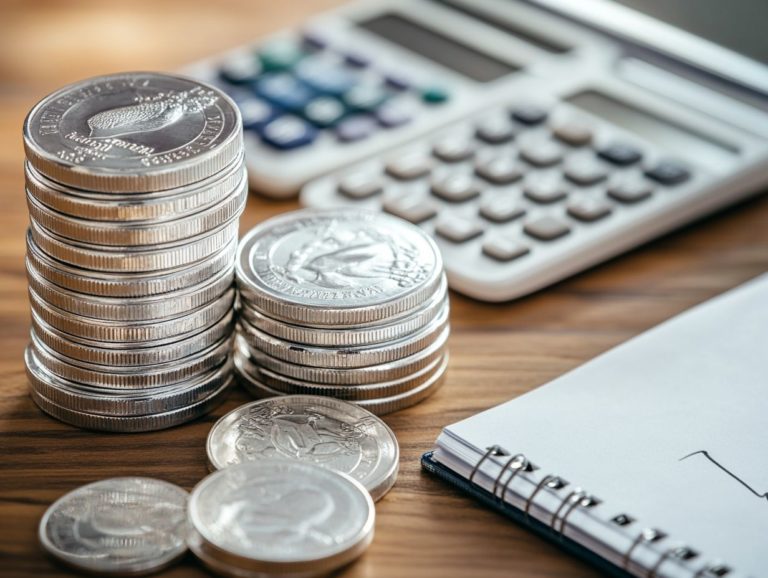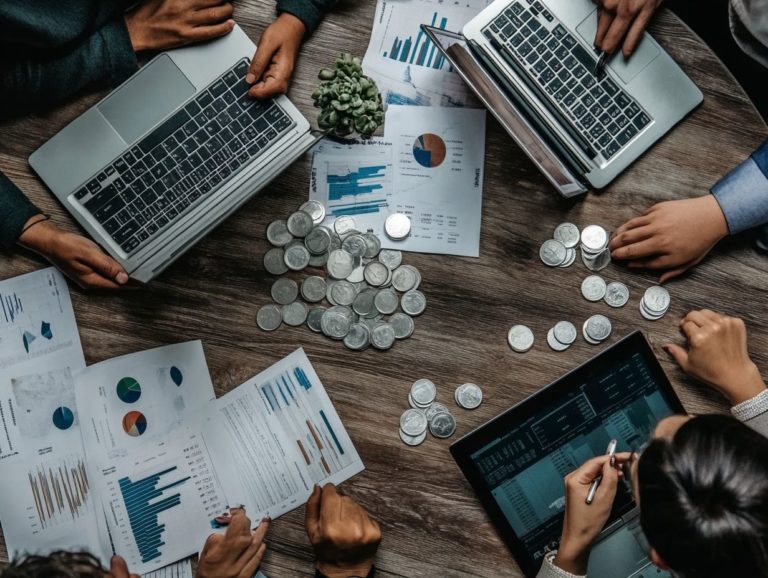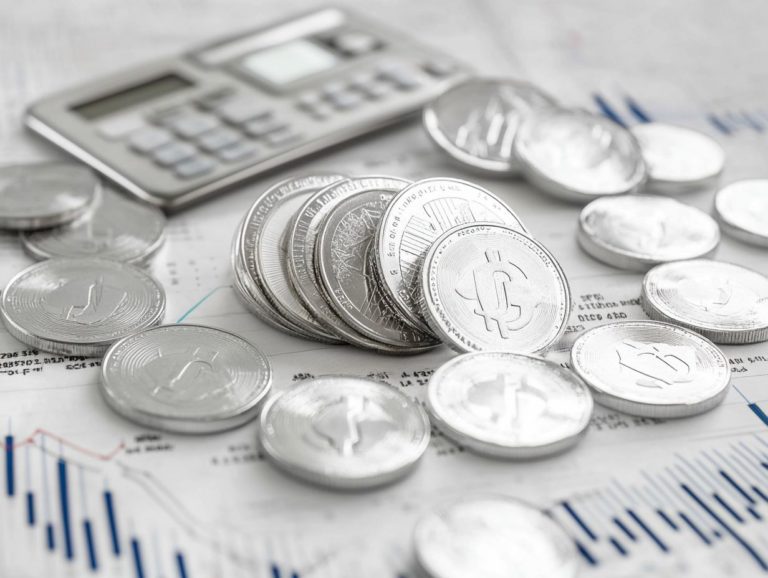Investing in Silver Jewelry: Pros and Cons
Silver jewelry has long captured the hearts of many as a favored choice for both adornment and investment, attracting those who truly appreciate its beauty and real value.
As you consider diversifying your portfolio, understanding the pros and cons of investing in silver jewelry becomes essential. Discover the fantastic affordability and stunning versatility of silver in this guide!
This guide will explore the affordability and versatility of silver, its long-term value, and key factors to keep in mind before making a purchase. You’ll find a discussion on potential downsides, such as tarnishing and market fluctuations, along with alternatives to investing in silver jewelry.
Whether you’re a seasoned investor or just embarking on your journey, this guide will equip you with the knowledge you need to confidently navigate the intriguing world of silver jewelry investment.
Contents
- Key Takeaways:
- Pros of Investing in Silver Jewelry
- Cons of Investing in Silver Jewelry
- Factors to Consider Before Investing in Silver Jewelry
- Alternatives to Investing in Silver Jewelry
- Frequently Asked Questions
- What are the advantages of investing in silver jewelry?
- Are there any drawbacks to investing in silver jewelry?
- How does the value of silver jewelry appreciate?
- What are the different forms of silver jewelry to invest in?
- Is investing in silver jewelry a long-term or short-term investment?
- How can I ensure the authenticity of my silver jewelry investment?
Key Takeaways:
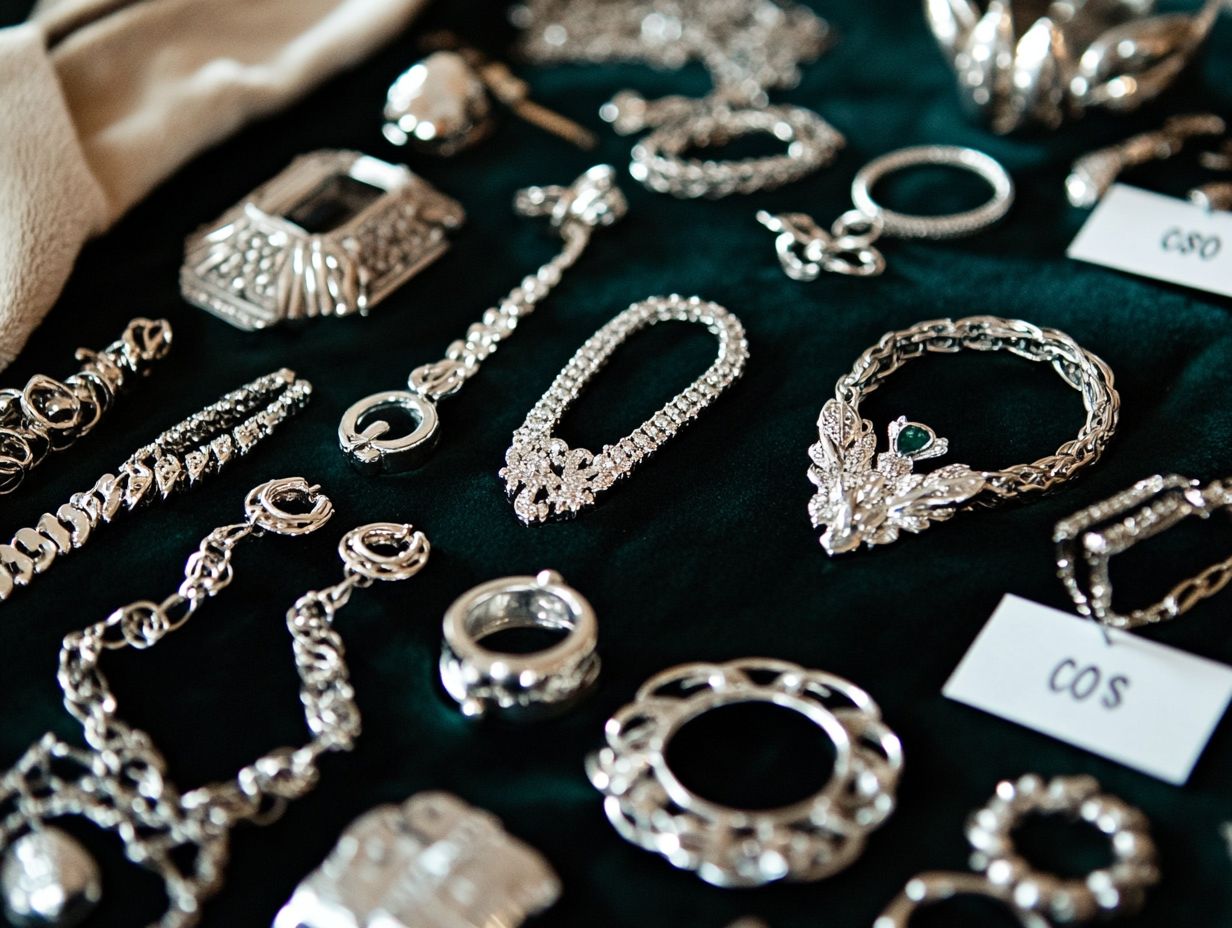
- Investing in silver jewelry can be a budget-friendly way to add versatility to your collection, as it is more affordable than other precious metals.
- While silver may not have the same long-term value as gold, it can still hold its value over time and be a good investment option for those who prefer a lower risk investment.
- Before investing in silver jewelry, consider its quality and authenticity. Stay informed about current market trends to seize the best opportunities.
What is Silver Jewelry?
Silver jewelry, often crafted from sterling silver, a high-quality type of silver used for jewelry, and various alloys, is an exceptional choice for those who seek beautiful, timeless pieces that effortlessly enhance any outfit.
This precious metal, celebrated for its lustrous shine, has graced jewelry-making for centuries, evolving into a staple in countless collections.
Its versatility invites a range of designs, from intricate creations adorned with stones to minimalist styles that resonate with modern sensibilities.
The rich history of silver jewelry stretches back to ancient civilizations, where it was cherished not just for its aesthetic allure but also for its intrinsic value.
Historically, artisans crafted remarkable pieces that showcased their skill and cultural significance, establishing silver as a symbol of wealth and sophistication.
Today, it retains its allure, captivating fashion enthusiasts who understand its power to elevate both casual and formal attire.
The durability of sterling silver makes it an ideal choice for everyday wear, allowing you to seamlessly integrate stunning jewelry into your life without compromising on quality.
Pros of Investing in Silver Jewelry
Investing in silver jewelry provides you with a range of compelling benefits that make it an attractive addition to your jewelry collection, particularly if you’re looking to diversify your investment portfolio.
Sterling silver, being more affordable than other precious metals, serves not only as an exquisite accessory but also as a potential safeguard against financial uncertainty.
The long-term value of high-quality silver jewelry can appreciate significantly, influenced by market dynamics (the forces that affect supply and demand) and industrial demand (the need for silver in various industries).
Affordability and Versatility
One of the standout advantages of silver jewelry is its affordability, making it an excellent choice for you if you’re looking to purchase something beautiful without draining your wallet.
This budget-friendly trait, paired with the natural versatility of sterling silver, opens the door to a plethora of styles and designs that effortlessly transition from casual outings to more formal events.
Whether you choose a sleek silver pendant to elevate a simple tee or a striking pair of silver earrings to complement an elegant evening gown, the adaptability of silver jewelry truly shines.
With sterling silver s capacity to be molded into intricate patterns, shapes, and finishes, it caters to diverse tastes, ensuring that every piece resonates with your personal style and is perfectly suited for any occasion.
Long-Term Value
Investing in silver jewelry can offer you significant long-term value, especially during times of financial uncertainty when precious metals tend to serve as a safe haven for savvy investors.
Silver’s appeal goes beyond its beauty. Its value often increases when market conditions change. Silver isn’t just a delightful choice for adornment; it’s also a smart choice, particularly in economic downturns when stability becomes paramount. Additionally, for those considering jewelry as an investment, understanding the pros and cons of investing in gold jewelry can provide valuable insights.
With the rising demand for silver across various industries ranging from technology to renewable energy its significance in an investment portfolio is only set to grow. By understanding how global market dynamics influence silver prices, you can make informed decisions that align with your investment goals.
Therefore, as you consider silver jewelry, it’s important to recognize the beauty and value of silver as a valuable long-term asset.
Cons of Investing in Silver Jewelry
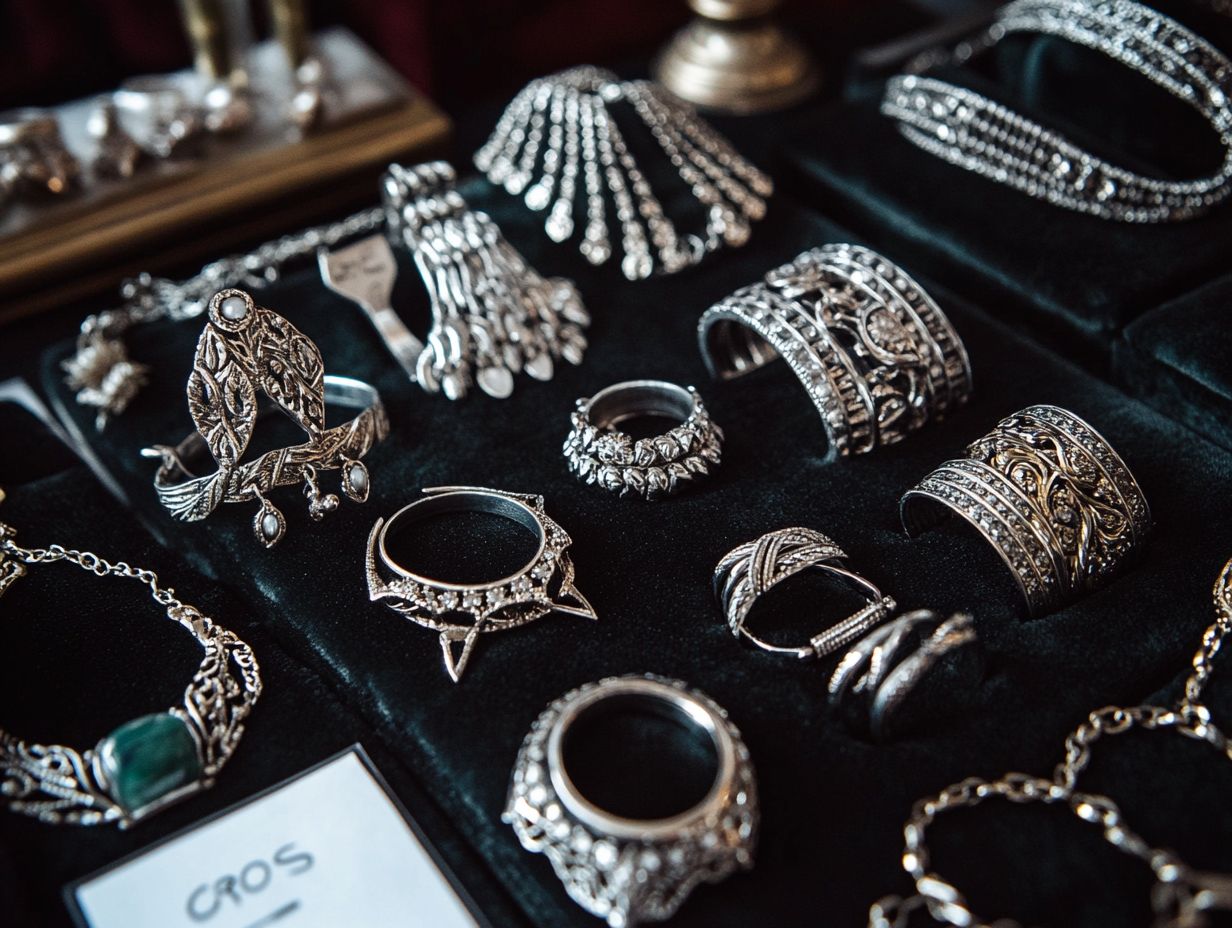
Investing in silver jewelry certainly has its advantages, but it’s equally important for you to weigh the potential drawbacks that could influence your decision-making process, particularly if you’re new to the silver investment market.
Potential for Tarnishing and Damage
One significant drawback of silver jewelry is its tendency to tarnish, which can diminish its visual allure and necessitates regular upkeep to preserve its luster. This tarnishing happens when silver encounters sulfur compounds, which are common in the air, moisture, or even specific skin types, triggering a chemical reaction that results in a dark layer of corrosion.
To keep your silver pieces shining, store them in an airtight container and polish them regularly with a soft cloth. Using anti-tarnish strips or cloths specifically designed for silver alloy can provide an extra layer of protection, ensuring your cherished items remain as dazzling as the day you acquired them.
Market Fluctuations
Market fluctuations in silver prices can indeed present a challenge for you as an investor. The value of silver jewelry doesn’t always mirror broader economic conditions, especially during periods of economic downturn.
These price changes can affect your investment quickly. They create significant variations in the market value of your pieces, influenced by demand, production costs, and geopolitical factors. You’ll soon see how price changes affect your investments. When the economy takes a hit, consumer purchasing power often diminishes, which can lead to a decline in demand for fine silver jewelry. To better understand the dynamics involved, consider exploring the risks and rewards of silver investing.
This cycle complicates how silver’s market trends align with a diversified investment strategy. As a savvy investor, you need to stay informed about external economic indicators that could affect your holdings.
Factors to Consider Before Investing in Silver Jewelry
Before investing in silver jewelry, consider these key factors to make a wise and informed decision about purchasing silver jewelry.
Check Quality and Authenticity
Make sure to check the quality and authenticity of silver jewelry, as these factors significantly influence its value and longevity.
Recognizing the difference between high-quality sterling silver and lower-quality alternatives, such as silver-filled jewelry, is essential for making informed purchasing decisions. Sterling silver typically carries a 925 stamp, indicating it contains 92.5% pure silver, while its cheaper counterparts might consist of a mere fraction of that.
When exploring your options, it s crucial to seek out reputable sources known for their commitment to authenticity and transparency. This diligence not only ensures that you are investing in genuine materials but also protects you from the disappointment that often accompanies inferior-quality pieces.
Current Market Trends
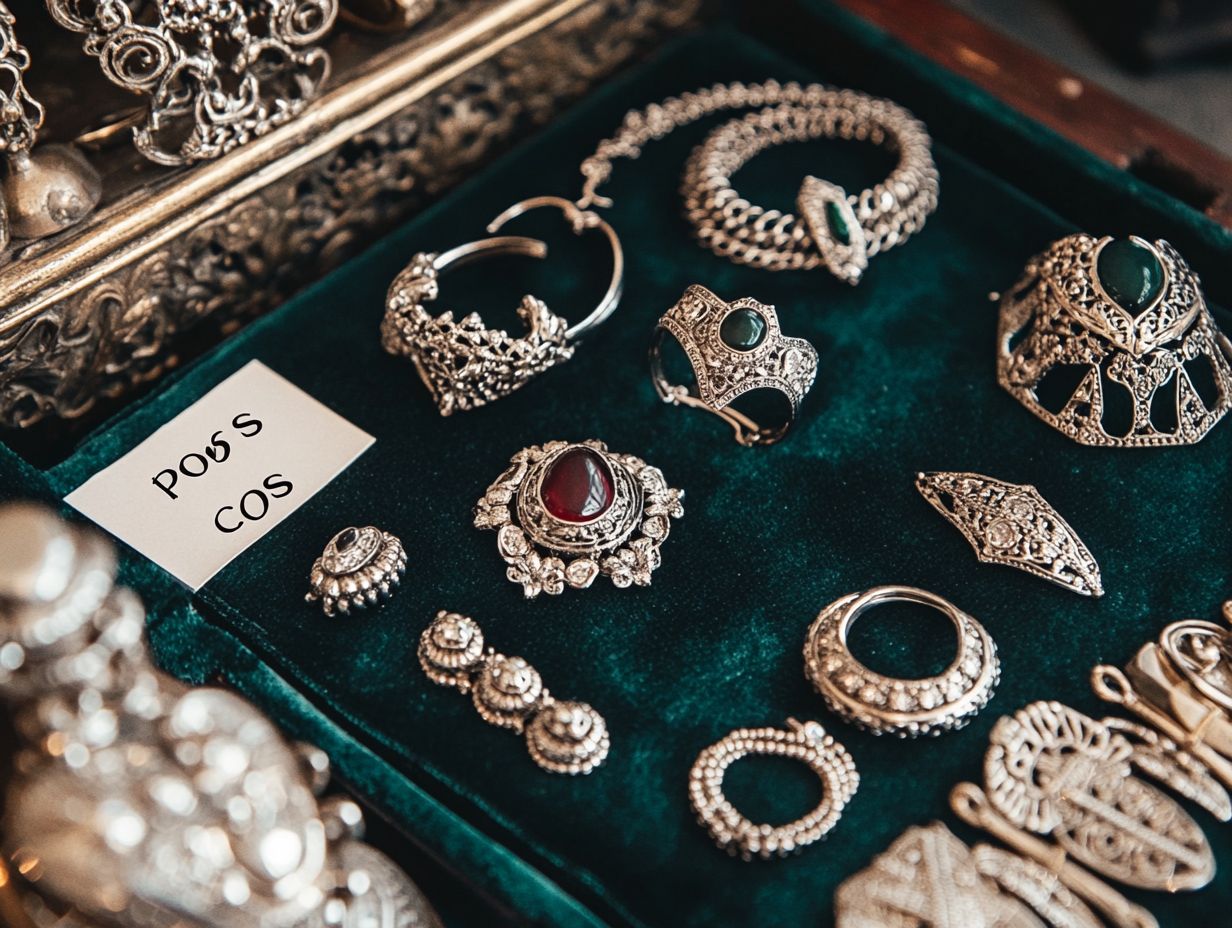
Keeping abreast of current market trends is essential for anyone considering investing in silver jewelry. Fluctuations in silver prices can significantly impact its investment value.
The dynamics of supply and demand are key players in determining these price movements. They are shaped by both industrial applications and the rising popularity of silver in renewable energy sectors, such as solar panels.
Recent reports highlight a tightening supply due to global events that affect politics impacting mining activities. Meanwhile, increasing consumer interest has ramped up demand among investors seeking safe-haven assets.
Economic factors, like inflation, can drive silver prices. It s vital for you, as a potential investor, to stay informed about these market dynamics to make savvy decisions.
Shifts in consumer sentiment can also influence the market. Be proactive to ensure you re not missing out on potential gains!
Alternatives to Investing in Silver Jewelry
If you’re feeling uncertain about committing entirely to silver jewelry, rest assured there are numerous alternatives within the precious metals sector. These options can help diversify your investment portfolio and mitigate risk.
Exploring Other Precious Metals
Exploring other precious metals, such as gold, can add vital layers of security and potential returns to your investment portfolio.
This asset class transcends mere aesthetics. Unlike silver jewelry, which, while beautiful, often lacks the same level of market stability and intrinsic value, gold is frequently touted by wealth management experts.
Gold’s historical performance serves as a way to protect your money’s value when prices rise and economic uncertainty is present. This makes it a go-to recommendation among financial advisors.
By considering investments in gold and other precious metals, you ll tap into a stronger, more dependable market that offers exciting opportunities. Ultimately, diversifying can lead to more secure financial outcomes for you.
Frequently Asked Questions
What are the advantages of investing in silver jewelry?
Investing in silver jewelry can provide diversification to your investment portfolio. As a tangible asset, it is not affected by market fluctuations.
Additionally, it has a lower entry cost compared to other precious metals, making it accessible to a wider range of investors, but it’s important to consider the pros and cons of Gold IRAs before investing.
Are there any drawbacks to investing in silver jewelry?
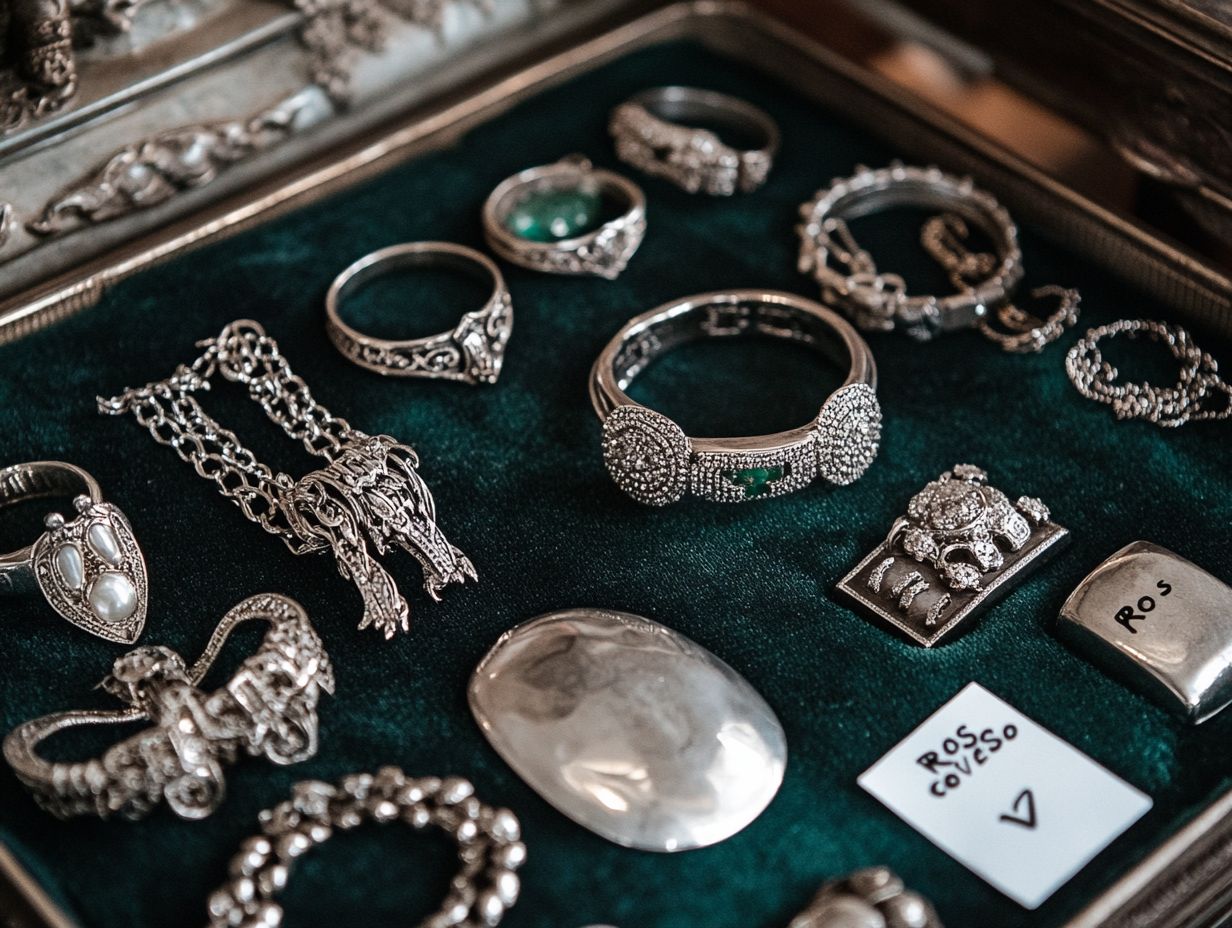
One of the main drawbacks of investing in silver jewelry is its low liquidity. Unlike stocks or bonds, selling your silver jewelry may take longer and converting it back into cash can be challenging.
There is also the risk of theft or damage to the jewelry, which can impact its value.
How does the value of silver jewelry appreciate?
The value of silver jewelry is primarily driven by the demand for the metal. As with any commodity, high demand and limited supply tend to increase value.
This can be influenced by economic conditions, fashion trends, and other factors.
What are the different forms of silver jewelry to invest in?
Investors can choose to invest in silver jewelry in various forms, such as bullion coins, bars, and numismatic coins. Each form has its own advantages and disadvantages.
It is important to research and understand the differences before making a purchase.
Is investing in silver jewelry a long-term or short-term investment?
Investing in silver jewelry can be both a short-term and long-term investment, depending on your goals and strategy. Some investors may buy and sell quickly for short-term gains.
Others hold onto their investments for longer periods to potentially reap larger profits.
How can I ensure the authenticity of my silver jewelry investment?
To ensure the authenticity of your silver jewelry investment, it is important to purchase from reputable dealers. Obtaining a certificate of authenticity is also advised.
Familiarize yourself with the characteristics of genuine silver jewelry to spot any potential fakes.
For personalized advice, consider contacting a financial advisor today!










